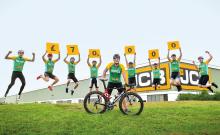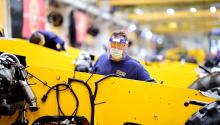Principal electronics engineer James Morey has converted the garage at his Derbyshire home to produce the PPE supplies.
Also, JCB - which closed all its UK manufacturing plants in March and furloughed most of its staff due to the coronavirus pandemic - has re-opened its Innovation Centre at the World HQ in Rocester. This has enabled tooling and moulding engineers Joe Mumby and Joe Bagley to volunteer and use the company’s 3D rapid prototype machines to help produce medical-grade visors for NHS workers.
For Joe Mumby, of Hilton, Derbyshire, volunteering to produce the vital NHS kit has also taken on a poignant significance as he and his family come to terms with the death of his father’s cousin from coronavirus in the past few days.
He said: "Helping with the production of visors is the least I could do as this is a very testing time for everyone, including my own family. It’s fantastic that JCB has given us the opportunity to give something back to those who are the front line of the virus during what must be a very scary time for them."
So far, the volunteer production line set up at JCB has produced 50 visors for distribution to surgeries in the Rocester and Uttoxeter area with the help of material donated by the JCB Academy.
With the visor material now exhausted, Joe and Joe are concentrating their efforts on producing hundreds of headbands required for the visors before despatching them to a Warwickshire company for final assembly.
Meanwhile, James Morley, who was the original inspiration for the project, has transformed his rapid prototyping machine in the garage of his home in Belper, near Derby from making toys for his two children to producing NHS kit.
Having made 20 visors, he is now diversifying his domestic production line to manufacture components, which convert snorkelling masks for use with hospital ventilators. He is also rapidly protoyping so-called ‘superhero nurse’ headbands which make face masks more comfortable for medical staff to wear as they fit on the back of the head rather than on to the back of ears.
He said: “While browsing social media on the state of the Covid-19 situation, I was aware that there was a huge shortage of medical-grade personal protective equipment for our NHS and other healthcare communities around the UK. It made me dust off my 3D printer and help contribute to the fight against Covid-19 and support our heroic NHS."
3D printers take computer-aided design data and build it into a 3D object using very fine layers of melted plastic. The plastic is heated up to around 210°C and then extruded on to a flat metal plate, also heated to about 60°C. Over the next few hours, the printer will finish the object before it is peeled off the flat plate and used.







